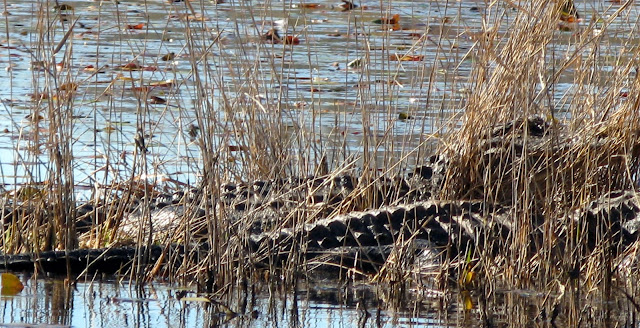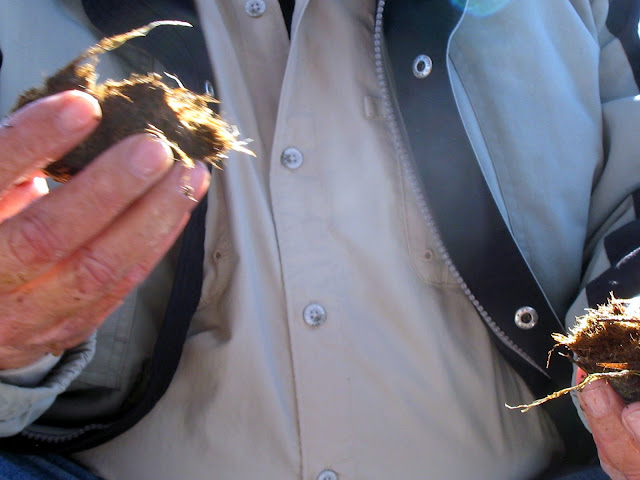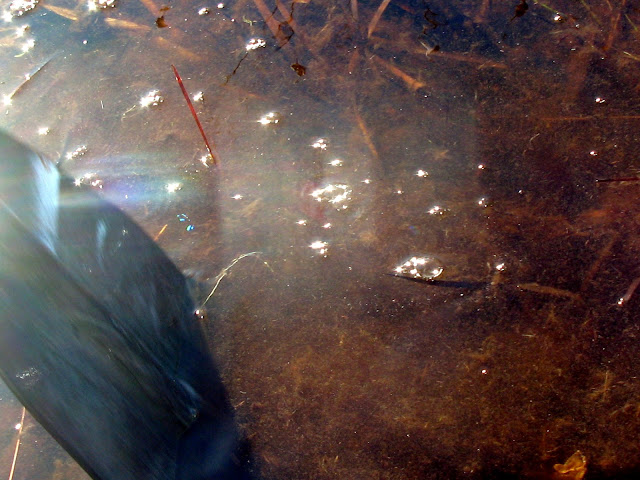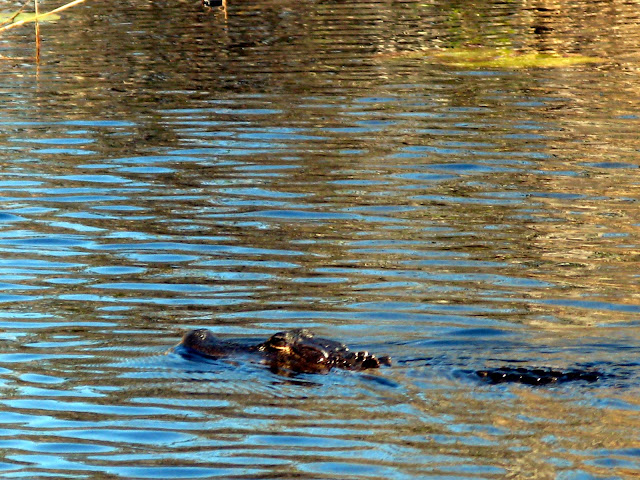#5 Welcome back and thanks for joining me at Okeefenokee Pastimes Cabins and Campgrounds in Folkston, Georgia. After a fuel stop, I arrived around 5:30 pm just as dusk bestowed its after-sunset chill. I was told the night before, temps dipped down to 28º. My first night was 36º. Anticipating the cold, Mike from the campground topped off my propane tank and I was set for the night. The campground is rustic but with the necessary services I'll need like 30 amp power, water and sewage. Charlene in the office provided me with two menus for the foods that are served right in the back of the office in their café. Lunch Monday-Thursday 11:00 am to 2:00 pm and another for Thursdays thru Saturdays from 11:00 am till 8:00 p.m. I will be visiting.
The Okefenokee is the largest, intact, un-fragmented, freshwater, and black water (tannic acid due to decaying vegetation) wilderness swamp in North America. "Okefenokee" was the name used by the indigenous Creeks and was believed to mean, "Land of Trembling Earth". As it turns out, that's a popular but very loose and many believe incorrect translation. "Oka" means water in the Hitchiti Creek language and "Fenoke" means shaking in Hitchiti. So the original meaning of Okefenokee is more like "Waters Shaking" not the commonly held "Land of Trembling Earth." On average the water is from two to ten feet deep.
I've mentioned this in a previous blog but as a reminder to those folks who take the time to comment (Thank you), comment as ANONYMOUS and before you PUBLISH, place a check in the NOTIFY ME box that appears to the right. Theoretically, you will receive a notification when I respond. Give it a try.
 |
| Charlene & Mike. Super friendly and accommodating. |
 |
Southern tip touches Florida's northern
border. |
If you followed the link of the campground above, you'll see I'm about 5 miles from the Okefenokee Wildlife Refuge. The entrance road is opposite the campground. This 438,000 acre (almost half the size of Rhode Island) natural wonder has an estimated 23,000 resident alligators and attractions I'm eager to visit. At the bottom of the link for this campground are the attractions available. The Swamp spans 38 miles north to south and 25 miles, east to west. The white sandy soil gives testimony that this entire area was part of the Atlantic Ocean before receding to the present day coastline.
"Visitors enjoy the opportunity to learn about the Okefenokee on our tours aboard our 24 ft. Carolina Skiffs. These are flat-bottomed boats with ample seating and canopies overhead. They are comfortable, very stable and very safe!
You will travel along the historic Suwannee Canal through a tangled forest of bay, cypress, pine and shrubs, then out into the open expanse of Chesser Prairie. Our guides will share their knowledge of the swamp’s cultural and natural history, tell interesting swamp stories and identify plants and wildlife along the way.
We frequently encounter egrets, herons, ibis, sandhill cranes, red-shouldered hawks, and American alligators, as well as otters in the winter and wood storks in the summer and fall. Sometimes we spot deer or raccoons, or, when we are really lucky, a bobcat or a bear. Wildlife activity varies with water levels, season, time of day and reasons known only to the wildlife. The swamp scenery is always spectacular."
The tour:
.JPG) |
| Okefenokee, the largest blackwater swamp in North America, is believed to be a Creek Indian word meaning "trembling earth" as some of the "land" in the swamp is really partially buoyant peat deposits that move and shake when walked upon or when the wind blows on the vegetation and trees. The swamp covers approximately 640 square miles. Speaking of the "Creek Indians", I'm surprised to find that most folks don't know that the phrase, "Lord willing and the Creek don't rise," is not referring to rising waters but for the hope that the Indian nation doesn't "rise" and attack. |
.JPG) |
Directly across the road and 4.2 miles into the Refuge lies my destination:
a boat tour down the Suwanee Canal into the Honey Island Prairie. |
 |
| This was the scene on April 30, 2011. The Honey Prairie Fire, a massive wildfire in the Okefenokee Swamp, two days after a lightning strike in the swamp ignited the blaze. The fire burned more than 300,000 acres in the swamp over the next three months. |
.JPG) |
| The swamp has the distinction of birthing two major rivers: the St. Mary River flowing east to the Atlantic and the Suwanee River flowing southwest into the Gulf. |
.JPG) |
...can detect the gasses of decaying carcasses upon which they feed. They're a very
valuable addition to keeping this planet "clean." |
 |
| Photo by Jim E. Johnson |
.JPG)
One sees a lot of (nest) holes in the sides of dead pines. While doing my research of the Swamp, I learned a very interesting defense mechanism of the red-cockaded woodpecker, one of the many residents in the Swamp. After choosing a dead tree, it will peck away and build its nest within. It will then retrieve the sap or amber of other pine trees and dapple it around the opening. Its natural predator, the corn snake, can literally slither its way up the tree as much as 30' above the ground, usually the height of the nest, to enter and eat the eggs. However, when it approaches, the snake's sensitive underbelly encounters the irritating sap surrounding the hole and it quickly retreats...even falling from that height to avoid the irritant.
.JPG) |
| As fascinating and impressive were the mangrove forests of the Everglades I visited, the bald cypress struck me as equally fascinating both in their contributions to the habitat and well as the deciduous conifer itself. |
It was disheartening to hear that back in the day, before Teddy Roosevelt put an end to it, 400 million board feet of timber was cut and hauled away from the Swamp. They built a 500 mile railroad to accomplish the transport. One can imagine the work involved knowing these trees can grow up to 300' with trunk diameters of 6'. In this swampy environment, the heat, humidity, snakes and gators had to be a challenge. The term, "bald" derives from the fact that, in the fall, this conifer sheds its needles. "The rot-resistant heartwood of mature trees have been widely used to make fence posts, doors, flooring, caskets, cabinetry, boats, and more. However, these days they are harvested less for timber because they are slow-growing, and there are less of them than there once were. Another reason is these trees usually grow in wetlands, which causes difficulty for loggers. Bald cypresses have very important roles in the wild. Since they tend to grow along rivers and in wetlands, they are excellent at soaking up floodwaters and preventing erosion. They also trap pollutants and prevent them from spreading. Frogs, toads, and salamanders use bald cypress swamps as breeding grounds. Wood ducks nest in hollow trunks, catfish spawn in the submerged hollow logs, and raptors like bald eagles nest in the treetops." (Source: NWF) .JPG)
.JPG) |
The characteristic reptilian skin is more pointed and distinct compared to their
captive counterparts whose defense is not as necessary as it is in the wild. |
.JPG)
.JPG) |
You may already know that the environmental temperature of the air, water and nest determine the sex of the offspring. Just like sea turtles (At 81.86°F hatchlings will be male while above 88.8° hatchlings will be female), the American alligator incubating at 91.4oF will produce mostly male babies, while incubation temperatures below 86oF result in mostly females.
Half way through the tour, we purposely ran aground in Honey Island Prairie where Joey shutdown the motor and gave us a few minutes of that wonderful experience of "deafening silence." I highly recommend it whenever you're able to get the opportunity. The only evidence of civilization was the contrails of passing jet aircraft far above in an exceptionally clear, sunny cloudless sky. It was here where Joey moved to the front of the skiff to demonstrate more wonders of the Swamp. This area is referred to as a "prairie" and, as defined, an extensive flat or rolling area dominated by grasses. There is no mud in Okefenokee Swamp. The ebony, mirror-like surface is due to the rotting vegetation, some of which he scooped up out of the water.
|
.JPG) |
| No rotting odors whatsoever. Heavily saturated with water, |
.JPG) |
| ...he squeezed it dry to show.. |
.JPG) |
| ...the fibrous material, peat, within valuable for many uses by the early settlers in the Swamp. |
.JPG) |
| Joey pressed his paddle down into the submerged vegetation to release bubbles of methane gas, the result of decay. At night, he says, you can catch little flickers of blue light when methane comes in contact with the air; they have come to be known as "will-o-the-wisps." |
.JPG) |
| A large floating mass of peat |
.JPG) |
On our return trip, this youngster crossed our bow. Mothers are very protective of their young and will care for them for about a year while they learn feeding and survival tactics. More interesting facts about the life cycle of the American alligator can be found HERE.
|
.JPG) |
| To give you an idea of the reflective properties of the black water, this is a photo of the undisturbed waters ahead of us reflecting the view above. |
.JPG) |
| No problem. Not to worry. |
.JPG) |
| Back at dockside, the resident cormorant greeted our return. |
After lunch at their café, I drove the Swamp Island Drive. To keep this blog short, I'll write about that in my next blog. The sun is shining, I'm out at my picnic table writing, robins are scurrying around and the breezy sunny day is at 80º. As they say, "Life is good."

.JPG)

.JPG)
.JPG)
.JPG)
.JPG)
.JPG)
.JPG)
.JPG)
.JPG)
.JPG)

.JPG)
.JPG)
.JPG)
.JPG)
.JPG)
.JPG)
.JPG)
.JPG)
.JPG)
.JPG)
.JPG)

.JPG)


.JPG)
.JPG)
.JPG)
.JPG)
.JPG)
.JPG)
.JPG)
.JPG)
Well, Charlie, this was truly fascinating. Okefenokee? Who knew. I didn't know it even existed. I thought it was a fictional town or something like that. It looks beautiful and rejuvenating. Lucky you. OK, gonna press publish and see what happens. So far, I don't see the notify me box but let's see.....Hugs, S
ReplyDeleteThanks for the comment, S. And I see the "Notify Me" box when I type this response. I'm going to check it off and we'll see if you receive anything. Oh well. Anyway, welcome to the Okefenokee Swamp. It's an amazing experience.
DeleteNope, no notify box Charlie. I looked high, I looked low and no go on that. "tis a puzzlement!" S
ReplyDeleteThat's okay; appreciate your comment, as always
DeleteI couldn't get the Okefenoke red link to work. Loved the swamp stuff. I stopped there on one trip down south. Grandma
ReplyDeleteWhich "red link" are you speaking of. They're all working for me when I checked.
ReplyDelete"Read the fascinating human history of the Okefenokee. Here" All I get is "webpage not available"
ReplyDeleteJust clicked on the link and it looks good for me. Here's the link again: https://www.georgiaencyclopedia.org/articles/geography-environment/human-history-of-the-okefenokee-swamp/
DeleteEnjoyed the differences and similarities of the swamps. The Bald Cypress trees. Learned about a new tree species with this blog! ~vc
ReplyDeleteYes. Loads to learn. Just 3 1/2 hrs / 193 miles from you. A nice weekend trip.
DeleteThanks for the tour, Charlie. Swamps always give me the creeps. Those "gators" were looking at you as their dinner. LOL I don't see any "notify me" box to check.
ReplyDeleteThanks for the input. I asked Joey about "swamp creatures" but he didn't know or hear of any. Still, you'd love this one.
DeleteMust admit I wasn't keen on checking out a swamp tour but ended up highly captvated!. Your travels never cease to amaze me!
ReplyDeleteAbsolutely! Mr. Claustrophobic here, felt the same way about caverns. I've got 4 under my belt with another one the trip back home.
Delete